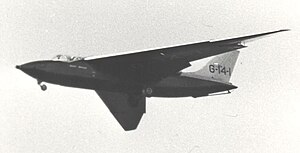Short SB.4 Sherpa
| Short SB4 | |
|---|---|

|
|
| Type: | Experimental aircraft project |
| Design country: | |
| Manufacturer: | |
| First flight: |
4th October 1953 |
| Number of pieces: |
1 |
The Short SB.4 Sherpa was a research aircraft ( " S hort & H arland E xperimental R esearch P rototype A ircraft") for the V-Bomber program of the Royal Air Force in the 1950s.
Design goal
Chief designer David Keith-Lucas planned to develop a wing for high speeds at high altitude, which was based on the so-called " aero-isoclinic wing " (in German about "wing with constant angle of attack") by Professor Geoffrey TR Hill . The basic idea was to mount the outer wing so that it can be rotated and always let it fly with a relatively low angle of attack, regardless of the angle of attack of the "rest of the" aircraft. In principle, it is most likely to be tailerons that have been moved to the wingtip.
draft
The design was based on Hills' experiments with Westland-Hill pterodactyl planes in the 1920s. The first test glider , Short SB1 , was built in 1950 and was flown in by chief test pilot Tom Brooke-Smith on July 14, 1951. Since it was recognized relatively early that conventional horizontal stabilizers with rudder flaps were no longer effective in the transonic area, the principle of a pendulum stabilizer was chosen (see North American F-100 and Mikojan-Gurevich MiG-19 ).
construction
The fuselage was made of light metal, the wing was largely made of wood and only the load-bearing parts were partially reinforced with aluminum. The two small Turbomeca Palas engines, each weighing only 75 kg, obtained their air through a NACA hood on the top of the fuselage and the exhaust gas jet was blown out through two nozzles above the trailing edge of the inner wing. A conventional vertical tail was located at the end of the fuselage. The landing gear was not retractable because the machine was not intended for high-speed tests.
The inner wing was designed with two spars and extremely torsionally stiff in order to be able to absorb the forces of the axis of rotation and had a 42 ° sweep on the leading edge. There were expansion flaps on the underside of the inner wing. The axis of rotation was in the aerodynamic neutral point of the outer wing and at the level of the trailing edge of the wing center part in order to obtain sufficient moment around the transverse axis. The outer wing was balanced in terms of weight and Flettner auxiliary rudders were attached to the rotating wing tips to generate control pressure. The area of the rotatable wing tips was about 20% of the total wing area.
First flight and testing
Brooke-Smith flew the SB4 for the first time on October 4, 1953, and the test program at Short spanned the next year and a half. The flight tests were generally satisfactory, but the “fourth V-bomber” was never built. Then the machine was transferred to the " College of Aeronautics " in Cranfield and used for further flight tests until 1958. Then an engine failure temporarily put the machine out of action, but after a replacement engine was found, testing continued until 1964. The aircraft was then handed over to the Bristol College of Advanced Technology for study purposes. The fuselage was later exhibited in the Norfolk and Suffolk Aviation Museum until July 2017. After that, the Ulster Aviation Society took over the machine for restoration.
Technical specifications
| Parameter | Data |
|---|---|
| length | 9.7 m |
| span | 11.58 m |
| height | 2.77 m |
| Wing area | 21.4 m² |
| Empty mass | 1400 kg |
| Top speed | ~ 275 km / h |
| Cruising speed | 188 km / h |
| Flight duration | 45-50 min |
| drive | 2 Turbomeca Pallas each with 160 kp thrust |
literature
- Bill Gunston: Airplane Monthly , Oct. 1977, pp. 508-515. "Short's Experimental Sherpa."
- Rudolf Storck et al. a .: Flying Wings . The historical development of the world's tailless and flying wing aircraft. Bernard and Graefe, Bonn 2003, ISBN 3-7637-6242-6 .
Web links
- Video flight recordings
- Flight magazine from October 1953

